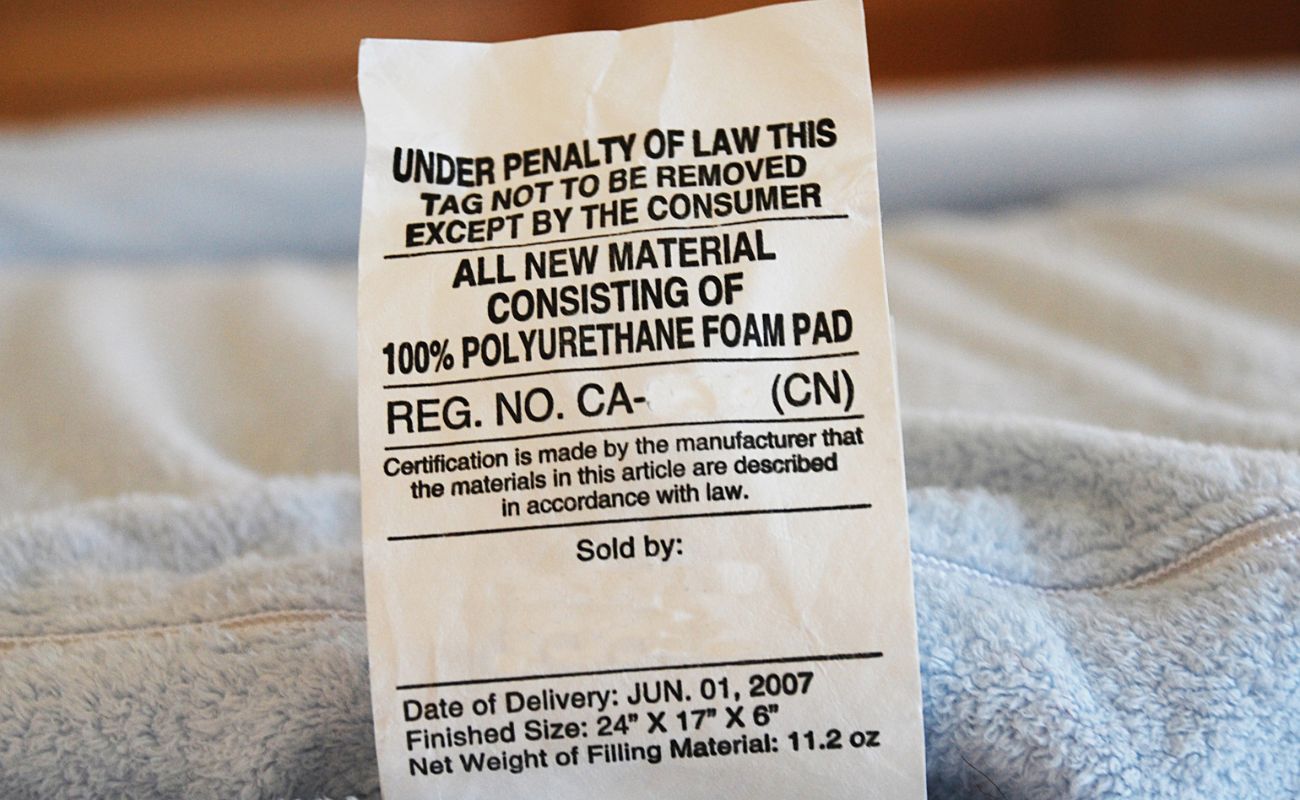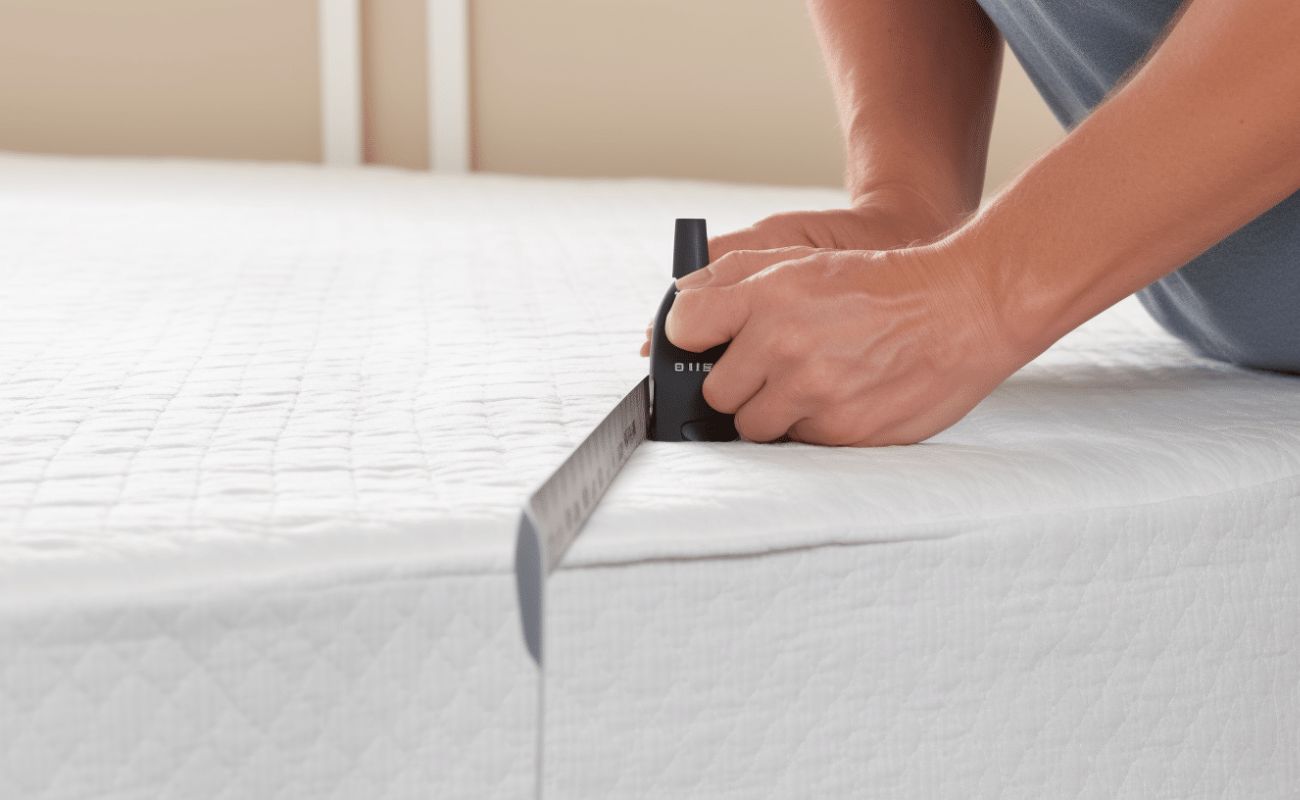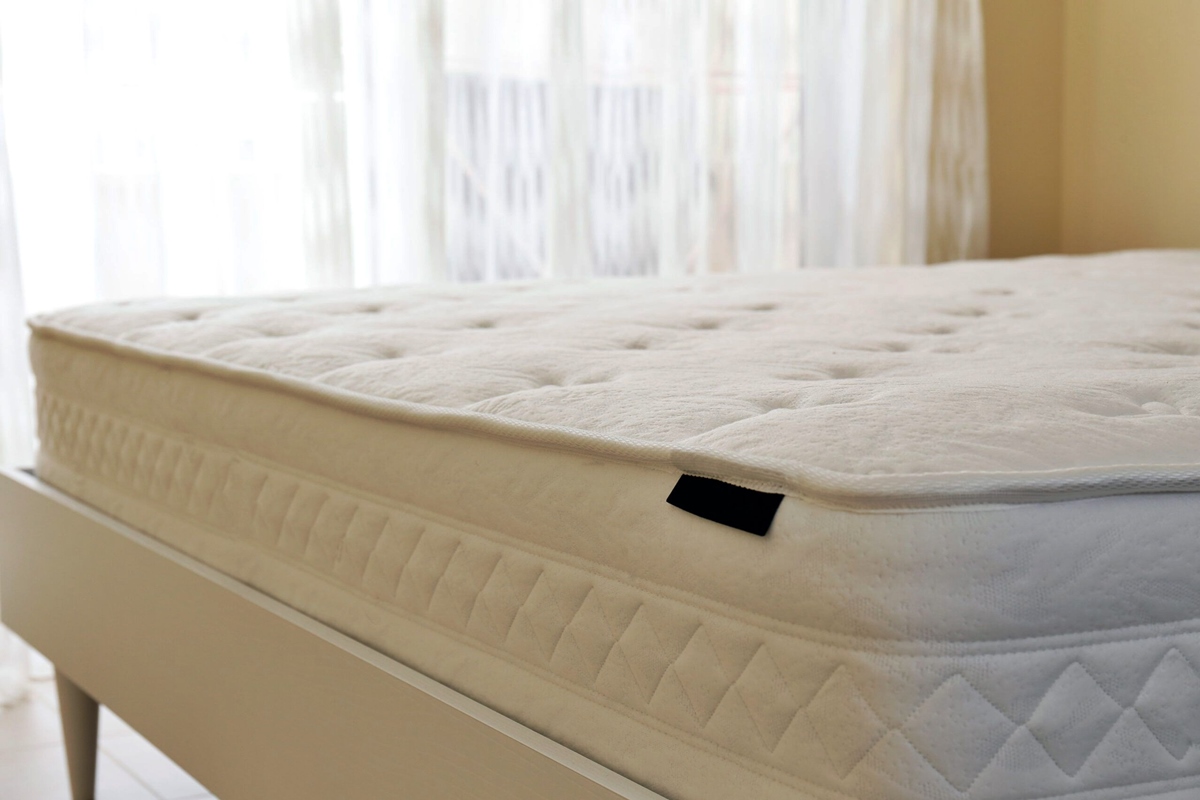Home>Furniture>Bedroom Furniture>Why Is It Illegal To Cut Off Mattress Tags


Bedroom Furniture
Why Is It Illegal To Cut Off Mattress Tags
Modified: March 2, 2024
Curious about the legality of cutting off mattress tags? Learn why it's illegal and how it relates to bedroom furniture.
(Many of the links in this article redirect to a specific reviewed product. Your purchase of these products through affiliate links helps to generate commission for Storables.com, at no extra cost. Learn more)
Introduction
When it comes to purchasing a new mattress, you may have noticed a pesky little tag attached to it. This tag contains important information about the product, including its materials, manufacturing details, and safety certifications. But have you ever wondered why it’s illegal to cut off mattress tags? In this article, we will dive into the reasons behind this regulation and explore the role of mattress tags in ensuring consumer safety.
Before delving into the details, it’s important to understand the purpose of mattress tags. These small labels are not just random pieces of fabric; they serve a crucial function in the bedding industry. Manufacturers are required to attach them to mattresses to provide consumers with essential information about the product they are purchasing.
The primary purpose of mattress tags is two-fold: to provide transparency about the materials used in the mattress and to ensure compliance with safety standards. When you purchase a mattress, you want to know what it’s made of, whether it contains any allergens, and if it meets certain safety regulations. The information provided on the tag helps you make an informed decision while ensuring that the mattress meets industry standards.
Labeling requirements for mattress tags are mandated by consumer protection laws. These laws vary from country to country, but they generally require manufacturers to provide specific information on the label. This may include details such as the manufacturer’s name or address, the mattress’s composition, fire resistance standards, and any certifications obtained.
The existence of these regulations is crucial to protect consumers from fraudulent practices. By requiring manufacturers to provide accurate and detailed information on the mattress tag, consumers can make informed decisions based on safety and quality.
Now that we understand the purpose of mattress tags and the importance of consumer protection laws, let’s examine some misconceptions surrounding cutting off these tags.
Key Takeaways:
- Mattress tags are not just pesky labels; they are crucial for consumer safety, transparency, and warranty validation. Cutting them off can lead to legal consequences and compromise consumer rights.
- Preserving mattress tags is essential for informed decision-making and warranty protection. Reforms such as digital information integration and enhanced online verification can further empower consumers and enhance industry standards.
The Purpose of Mattress Tags
Mattress tags serve multiple purposes beyond just providing information. They play a vital role in ensuring consumer safety, promoting transparency in the bedding industry, and protecting consumers’ rights. Let’s delve into the key purposes of mattress tags:
- Product Transparency: One of the primary purposes of mattress tags is to provide transparency about the product’s composition and manufacturing details. The tag usually contains information about the materials used in the mattress, such as the type of foam or coils, upholstery layers, and fabric covers. This transparency allows consumers to assess the quality of the mattress and make informed purchasing decisions based on their preferences and needs.
- Safety Compliance: Another crucial purpose of mattress tags is to ensure compliance with safety regulations. Mattresses are subject to various safety standards depending on the country or region. These standards often include fire resistance requirements to minimize the risk of mattress-related fires. The tag provides information about whether the mattress meets these safety standards, helping consumers choose products that prioritize their safety.
- Consumer Education: Mattress tags also serve as a tool for consumer education. The information provided on the tag helps buyers understand the features, benefits, and potential drawbacks of the mattress. Consumers can learn about important details such as the mattress’s durability, firmness level, hypoallergenic properties, or specific certifications. This knowledge empowers consumers to make informed decisions based on their individual preferences and needs.
- Warranty and Support: Many mattress manufacturers offer warranties or guarantees on their products. The tag often includes information about the warranty period, terms, and conditions. By keeping the mattress tag intact, consumers can reference it when seeking assistance or filing a warranty claim. Additionally, mattress tags may provide contact information for customer support, making it easier for consumers to reach out for assistance.
- Legal Compliance: In some countries, cutting off the mattress tag is considered illegal due to labeling requirements mandated by consumer protection laws. These laws ensure that consumers have access to accurate information about the product they are purchasing, protecting them from false advertising or misrepresentation. The mattress tag serves as evidence that the product has met the required labeling standards and helps hold manufacturers accountable.
Overall, the purpose of mattress tags extends well beyond a mere label attached to a product. They play a critical role in providing product transparency, ensuring compliance with safety standards, educating consumers, and advocating for their rights. By understanding the significance of mattress tags, consumers can make more informed and confident choices when purchasing their next mattress.
The Labeling Requirements for Mattress Tags
When it comes to labeling requirements for mattress tags, each country or region may have its own set of regulations and standards. These requirements aim to provide consumers with important information about the product they are purchasing and ensure transparency in the bedding industry. Let’s explore some common labeling requirements for mattress tags:
- Manufacturer Information: Mattress tags typically include the manufacturer’s name or registered trademark, as well as their address or contact information. This allows consumers to identify the company responsible for producing the mattress and facilitates communication in case of any issues or inquiries.
- Product Description: The tag must provide a clear and concise description of the mattress. This includes details such as the size (e.g., twin, full, queen, king), model name or number, and any additional variations or features (e.g., pillow-top, memory foam, hybrid).
- Material Composition: The tag should disclose the materials used in the construction of the mattress. This may include information about the type of foam (e.g., polyurethane foam, memory foam), upholstery layers, coil types (e.g., innerspring, pocketed coils), and any other significant components. By knowing the material composition, consumers can assess factors such as comfort, support, and potential allergens.
- Safety Certifications and Standards: Mattresses are subject to various safety regulations, especially those related to fire resistance. The tag should indicate whether the mattress complies with the applicable safety standards and certifications. This ensures that the mattress meets the necessary requirements to minimize the risk of fire accidents and promote consumer safety.
- Warranty Information: If a warranty or guarantee is provided by the manufacturer, the tag should include details such as the warranty period, terms, and conditions. This allows consumers to understand their rights and coverage in case of any defects or issues with the mattress. It is essential to retain the mattress tag for warranty purposes.
- Cleaning and Care Instructions: The tag should provide guidance on how to care for and maintain the mattress. This may include instructions on cleaning, rotating, or flipping the mattress, as well as advice on using mattress protectors or covers. Proper care and maintenance can prolong the lifespan of the mattress and ensure optimal performance.
It’s important to note that the specific labeling requirements may vary based on the country, region, or even state. Compliance with these requirements is crucial for manufacturers to demonstrate transparency, maintain consumer trust, and adhere to consumer protection laws. Consumers should familiarize themselves with the labeling requirements specific to their region and use the information provided on the mattress tag to make informed purchasing decisions.
Consumer Protection Laws and Mattress Tags
Mattress tags play a significant role in ensuring consumer protection and promoting transparency in the bedding industry. Consumer protection laws exist to safeguard consumers’ rights and interests, and mattress tags are closely regulated under these laws. Let’s explore how consumer protection laws relate to mattress tags:
Information Disclosure: Consumer protection laws require manufacturers to disclose specific information about the product to consumers. Mattress tags serve as a medium for this information disclosure. By providing details about the mattress’s composition, safety standards compliance, and warranty information, manufacturers fulfill their duty to disclose essential facts to consumers. This allows buyers to make informed decisions based on accurate and transparent information.
False Advertising Prevention: Consumer protection laws prohibit false, misleading, or deceptive advertising practices. Mattress tags contribute to preventing false advertising by offering a standardized format for information disclosure. Through the mandated labeling requirements, consumers can trust that the information provided on the mattress tag is accurate, helping them make purchasing decisions with confidence.
Safety Regulations Compliance: Mattresses are subject to safety regulations to protect consumers from potential hazards, such as fire accidents. Consumer protection laws establish these safety standards and require manufacturers to comply with them. By including safety certifications and compliance information on the mattress tag, manufacturers demonstrate their adherence to these regulations and assure consumers of a safer product.
Product Liability: In the event of a defective or unsafe mattress, consumer protection laws hold manufacturers responsible for product liability. Mattress tags play a vital role in this aspect as well. If a consumer experiences any issues or defects, the intact mattress tag serves as evidence to establish the product’s origin and the manufacturer’s responsibility. This allows consumers to seek recourse, including warranty claims or legal action if necessary.
Consumer Education and Empowerment: Consumer protection laws aim to empower consumers with the knowledge and information necessary to make informed choices. Mattress tags contribute to this objective by providing essential details about the product. By understanding the information on the tag, consumers can assess factors such as materials, safety compliance, and warranties to select a mattress that meets their comfort, safety, and quality preferences.
Overall, consumer protection laws ensure that manufacturers comply with certain guidelines regarding mattress tags. By providing accurate and comprehensive information, manufacturers uphold transparency, prevent misleading practices, and protect consumers from potential hazards. Understanding the role of consumer protection laws in relation to mattress tags allows consumers to exercise their rights and make well-informed decisions when purchasing a mattress.
Misconceptions about Cutting Off Mattress Tags
There are several misconceptions surrounding the act of cutting off mattress tags. While it may seem like a harmless action, it’s important to dispel these misconceptions to ensure consumer awareness and compliance with the law. Let’s address some common misconceptions about cutting off mattress tags:
Misconception 1: Cutting off the tag is legal once you’ve purchased the mattress. Many people believe that once they’ve purchased a mattress, they are free to remove the tag without consequences. However, this is not the case. In most countries, it is illegal to remove or tamper with the mattress tags, even after purchase. Consumer protection laws mandate the preservation of mattress tags to maintain transparency and protect consumers’ rights.
Misconception 2: Cutting off the tag won’t affect warranty claims. Some consumers mistakenly believe that removing the mattress tag will not have any impact on their ability to file warranty claims if the mattress has defects. However, the intact mattress tag is often required as proof of purchase and for warranty validation. If the tag is cut off, it may invalidate the warranty and make it challenging to pursue any claims for repairs or replacements.
Misconception 3: The tag is only meant for retailers or inspectors. Another common misconception is that the mattress tag is not relevant to the end consumer. Some individuals assume that the tag is only necessary for retailers or inspectors to verify the product’s authenticity or compliance. However, the mattress tag actually serves as a crucial source of information and protection for consumers. It provides details about the materials used, safety certifications, and warranty information, helping consumers make informed choices and seek recourse in case of issues.
Misconception 4: Removing the tag has no consequences. While it may seem inconsequential to remove the mattress tag, there can be legal consequences for doing so. In many countries, removing the tag is considered a violation of consumer protection laws and can result in penalties or fines. Additionally, tampering with the tag may impact the mattress’s resale value, as potential buyers may prefer a mattress with an intact tag as it provides assurance about the product’s authenticity and safety compliance.
Misconception 5: Cutting off the tag doesn’t affect the product’s safety. Some individuals argue that cutting off the mattress tag has no bearing on the mattress’s safety or performance. However, the tag serves as a means of ensuring compliance with safety standards. Without the tag, consumers may have no way of knowing if the mattress was manufactured in accordance with important safety regulations, potentially putting their safety at risk.
By dispelling these misconceptions, consumers can better understand the importance of preserving mattress tags. Adhering to consumer protection laws and keeping the tag intact not only ensures compliance but also enables consumers to exercise their rights, make informed decisions, and seek appropriate recourse if needed.
The tags on mattresses contain important information about the materials used and safety regulations. It is illegal to remove them because they provide crucial details for consumers and are required by law to remain on the mattress.
Read more: Why Is It Illegal To Remove A Mattress Tag
The Consequences of Removing Mattress Tags
Removing mattress tags may seem like a harmless act, but it can have several consequences that consumers should be aware of. These consequences, both legal and practical, highlight the importance of keeping mattress tags intact. Let’s explore the potential ramifications of removing mattress tags:
Legal Consequences: In many countries, removing mattress tags is a violation of consumer protection laws. It is considered illegal and can result in legal consequences. Depending on the jurisdiction, individuals who remove mattress tags may face penalties, fines, or even legal action. It’s important to remember that these laws are in place to ensure transparency, protect consumers’ rights, and hold manufacturers accountable.
Warranty Voidance: Cutting off the mattress tag can invalidate the warranty provided by the manufacturer. Most warranties require the intact mattress tag as proof of purchase and to validate any warranty claims. Without the tag, it becomes challenging to prove the authenticity or timeline of the purchase. This can result in the manufacturer refusing any warranty repairs or replacements, leaving the consumer responsible for any costs associated with fixing or replacing the mattress.
Resale Value Reduction: When it comes time to sell or donate a mattress, having an intact mattress tag can increase its resale value. Buyers and potential recipients often prefer mattresses with the original tags intact as it demonstrates the product’s authenticity and compliance with safety standards. By removing the tag, the resale value of the mattress may be significantly reduced as it raises doubts about the mattress’s history, safety, and potential warranty coverage.
Consumer Protection Compromised: Mattress tags serve as a means of consumer protection. By removing the tag, consumers lose access to important information about the mattress’s composition, safety certifications, and warranty terms. Without this information, consumers may find it challenging to make informed decisions about the product they are purchasing or to seek appropriate recourse in case of any issues or product defects.
Misrepresentation Risk: An intact mattress tag provides assurance to consumers that the product meets specific safety and quality standards. Without the tag, there is a risk of misrepresentation or fraudulent activities. Unscrupulous sellers could sell substandard or non-compliant mattresses without the necessary information disclosed. Consumers may unknowingly purchase mattresses that may not meet safety requirements or pose health risks.
Loss of Transparency: Mattress tags are designed to provide transparency by requiring manufacturers to disclose important details about the product. By removing the tag, consumers lose access to this transparency, making it more difficult to differentiate between the various mattress options available in the market. This can result in an uninformed purchase, potentially leading to dissatisfaction with the product or a mismatch in meeting the consumer’s needs and preferences.
Considering the legal and practical consequences of removing mattress tags, it is crucial for consumers to understand and comply with consumer protection laws. Preserving the mattress tag not only ensures legal compliance but also enables consumers to exercise their rights, make informed decisions, and seek appropriate assistance when necessary.
The Legal Justification for Making It Illegal to Cut Off Mattress Tags
The legal prohibition on cutting off mattress tags is based on several justifications that prioritize consumer protection and promote transparency in the bedding industry. These justifications highlight the importance of preserving mattress tags and the legal consequences associated with their removal. Let’s explore the legal justification for making it illegal to cut off mattress tags:
Consumer Safety: One of the key reasons for making it illegal to remove mattress tags is to prioritize consumer safety. Mattresses are subject to various safety standards, including fire resistance regulations, to minimize the risk of accidents. By keeping the tag intact, consumers have access to essential information about the mattress’s compliance with these safety standards. Cutting off the tag could potentially expose consumers to unsafe products without their knowledge.
Proof of Authenticity: The intact mattress tag serves as proof of authenticity, ensuring that the product is genuine and produced by a reputable manufacturer. Removing the tag can make it difficult to verify the origin and legitimacy of the mattress. This has led to the legal requirement of preserving the mattress tag as a means of protecting consumers from counterfeit or substandard products.
Consumer Education and Transparency: Mattress tags provide consumers with vital information about the product, including materials used, safety certifications, and warranty details. Preserving the tag promotes consumer education and transparency, allowing buyers to make informed decisions based on accurate and comprehensive information. Removing the tag could hinder consumers’ ability to access this information, potentially leading to uninformed choices and decreased transparency in the industry.
Enforcement of Consumer Protection Laws: Consumer protection laws play a crucial role in establishing guidelines and standards for the mattress industry. By making it illegal to cut off mattress tags, authorities can enforce compliance with these laws and hold manufacturers accountable for providing accurate information to consumers. The legal prohibition acts as a deterrent against false advertising, misrepresentation, and fraudulent practices that may deceive or harm consumers.
Preservation of Warranty Rights: Many mattresses come with warranties or guarantees provided by the manufacturers. These warranties often require the intact mattress tag as proof of purchase. Removing the tag can potentially void the warranty, leaving the consumer without any recourse for addressing defects or seeking repairs. The legality against cutting off mattress tags protects consumers’ rights to access warranty benefits and ensures manufacturers’ compliance with warranty obligations.
Industry Standardization: The requirement to preserve mattress tags contributes to industry standardization as well. By establishing a uniform method of information disclosure, it enables consumers to compare and evaluate different mattresses based on standardized criteria. This promotes fair competition within the market and ensures that consumers have access to consistent and reliable information when making their purchasing decisions.
Overall, the legal justification for making it illegal to cut off mattress tags revolves around consumer protection, safety, transparency, and the enforcement of industry standards. Preserving mattress tags is essential for consumers to make informed choices, protect their warranty rights, and ensure compliance with consumer protection laws. By upholding these legal requirements, authorities prioritize consumer well-being and maintain the integrity of the bedding industry.
Possible Reforms or Changes to the Law Regarding Mattress Tags
While the current laws regarding mattress tags aim to protect consumers and promote transparency, there is always room for improvement. As the bedding industry evolves and consumer needs adapt, it may be necessary to consider reforms or changes to the existing laws regarding mattress tags. Here are some potential reforms that could enhance consumer protection and address emerging challenges:
- Consumer Education Initiatives: Implementing comprehensive consumer education initiatives can enhance awareness of the importance of mattress tags. By educating consumers about the significance of preserving the tags and ensuring they have access to the necessary information, individuals are empowered to make informed decisions and avoid inadvertently removing the tags.
- Streamlined Labeling Requirements: Simplifying and standardizing mattress labeling requirements can improve clarity for both manufacturers and consumers. By establishing clear guidelines and eliminating unnecessary or redundant information, the labels can become more user-friendly and easily understood by individuals researching or purchasing mattresses.
- Augmented Digital Information: Integrating technology into mattress labeling can enhance the accessibility and depth of information. By using QR codes or other digital tools on the tags, manufacturers can provide consumers with additional details, such as product reviews, certifications, or even interactive product demonstrations. This would leverage digital platforms to meet the evolving needs of consumers in an increasingly digital world.
- Enhanced Online Verification: Creating online platforms or databases where consumers can verify the authenticity of their mattress purchases could be beneficial. This would provide a centralized resource for consumers to confirm the legitimacy of their mattresses and ensure compliance with safety standards, even if the physical tag is damaged or removed.
- Extended Warranty Validation: Exploring alternative methods for warranty validation, such as unique identifiers or online registration, can help consumers preserve their warranty rights even if the physical tag is removed. This would provide an alternative solution for consumers who accidentally discard or lose their mattress tags but still want to take advantage of warranty benefits.
- Updated Safety Standards: Regularly reviewing and updating safety standards for mattress construction can ensure that they reflect current technologies and materials. This would help manufacturers produce safer mattresses that meet evolving safety requirements. Updated safety standards can also inform the information disclosed on the mattress tags, ensuring consumers have the most relevant and accurate information.
It’s important to note that any reforms or changes to the law regarding mattress tags should be carefully considered and balanced with the need to protect consumers and maintain industry standards. It is crucial to involve all stakeholders, including manufacturers, consumer advocacy groups, and regulatory bodies, in the process to ensure that the reforms address the concerns of all parties involved.
By continually evaluating and adapting the laws regarding mattress tags, we can create a regulatory framework that promotes consumer safety, facilitates informed decision-making, and keeps pace with the evolving landscape of the bedding industry.
Conclusion
Mattress tags may seem like small, insignificant labels, but they play a vital role in ensuring consumer safety, promoting transparency, and protecting consumer rights in the bedding industry. Cutting off mattress tags is not just a harmless action; it can have legal consequences and hinder consumers’ ability to make informed decisions.
The purpose of mattress tags is to provide transparency about the product’s composition, compliance with safety standards, and warranty information. They empower consumers by providing essential details that enable them to make educated choices based on their preferences and needs.
Consumer protection laws mandate the presence and preservation of mattress tags to ensure compliance, prevent false advertising, and hold manufacturers accountable. These laws exist to safeguard consumers’ rights, protect their safety, and provide recourse in case of defects or issues with the mattress.
Removing mattress tags can lead to a range of consequences, including legal trouble, voided warranties, reduced resale value, compromised consumer protection, and loss of transparency. Preserving the tags is essential for consumers to exercise their rights, access warranty benefits, and make informed decisions.
Possible reforms or changes to the law regarding mattress tags could include consumer education initiatives, streamlined labeling requirements, augmented digital information, enhanced online verification, extended warranty validation methods, and updated safety standards. These reforms aim to enhance consumer protection, improve accessibility to information, and address emerging challenges in the industry.
In conclusion, by recognizing the importance of mattress tags and abiding by consumer protection laws, consumers can make confident and informed decisions when purchasing mattresses. Preserving the tags ensures transparency, protects consumer rights, and contributes to an industry that prioritizes safety and consumer well-being.
Frequently Asked Questions about Why Is It Illegal To Cut Off Mattress Tags
Was this page helpful?
At Storables.com, we guarantee accurate and reliable information. Our content, validated by Expert Board Contributors, is crafted following stringent Editorial Policies. We're committed to providing you with well-researched, expert-backed insights for all your informational needs.














